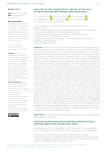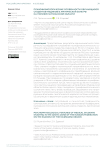Общественное здоровье. Рубрика в журнале - Российская Арктика

Analysis of the hydrological regime of the gulf of Ob in the freezing period using SMOS data
Статья научная
The Gulf of Ob is a unique ecosystem characterized by a complex interaction of river and sea factors. It is exposed to extremely strong seasonal pressure of highly variable temperature, insolation, biogenic load and many other factors, including anthropogenic and technogenic effects. Operational satellite data on the hydrological regime of the Gulf of Ob are crucial for the analysis of different environmental and climate processes as well as assessment of the intensity and scale of anthropogenic and technogenic impacts on the adjacent areas. This study presents an analysis of seasonal and interannual variations of brightness temperature in different parts of the Gulf of Ob in the freezing period based on SMOS (Soil Moisture and Ocean Salinity) data. It was found that in the southern part of the Gulf of Ob, the seasonal and interannual brightness temperature dynamics are similar to freshwater lakes. However, the closer to the Kara Sea the more these dynamics deteriorate and, finally, in the northern part of the Gulf, become similar to those of the central Kara Sea. During the freezing period, changes in the brightness temperature dynamics occur in different parts of the Gulf of Ob. This is explained by an increase in the salinity of water under ice. It was shown that during winter seasons, the zone of fresh and salt waters mixing (the transition zone) can shift far to the south of the Gulf of Ob. Winter shift of the transition zone was compared with climate changes in the region that determine the river runoff and the state of permafrost. The revealed patterns of brightness temperature seasonal variations in different parts of the Gulf of Ob and the associated ice cover phases can be used to assess the hydrological regime in large estuaries of the Arctic in winter, as well as climate changes in the adjacent areas on the basis of satellite microwave radiometry data.
Бесплатно

Статья научная
Представлены результаты одномоментного поперечного исследования показателей психофизиологического состояния организма студентов-медиков до 18 лет и старше, проживающих более 1 года в Мурманской области (группа 1) и вновь прибывших на обучение из других регионов России, проживающих на месте менее полугода (группа 2). Сравнительная оценка производилась по методикам: Ч. Д. Спилбергера в адаптации Ю.Л. Ханина (ситуативная и личностная тревожность); уровню стресса Ю.В. Щербатых «Комплексная оценка проявлений стресса»; степени стрессоустойчивости и социальной адаптации Холмса -Рея; степени нервно-психической напряжённости по интегральному показателю суммарного отклонения от аутогенной нормы и вегетативного коэффициента, преобладанию влияния симпатической и парасимпатической нервной системы на регуляцию процессов адаптации и по тесту цветопредпочтения М. Люшера. При сравнении по возрастному критерию в группе учащихся от 18 лет и старше субъективные показатели психофизиологического состояния лучше, чем в группе до 18 лет. Показано, что в группе учащихся, проживающих на территории Мурманской области более одного года, показатели психофизиологического состояния ниже, чем у вновь прибывших. Выражается это напряжением психоэмоциональных и физиологических систем, доминирующим влиянием симпатической нервной системы на процессы регуляции и вероятным срывом адаптационных механизмов.
Бесплатно

